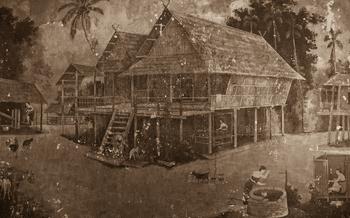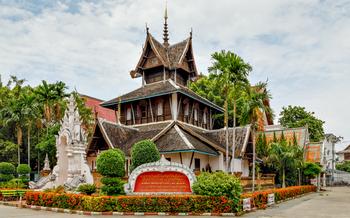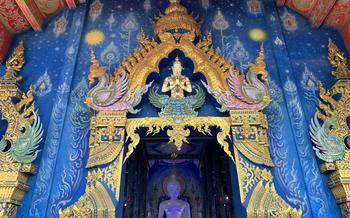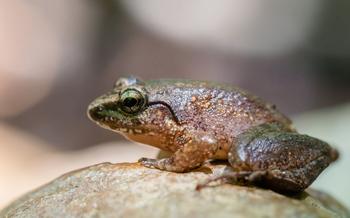
Wat Phra Kaeo Don Tao
- Location and Accessibility
- Hours of Operation and Admission Fees
- Admission Fees
- Guided Tours
- Dress Code and Etiquette
- Exploring the Temple Grounds
- Marveling at the Emerald Buddha
- Paying Respects at the Phra Phuttha Lertla
- Exploring the Viharn
- Admiring the Ordination Hall
- Discovering the Bell Tower
- A Walk Through the Ubosot
- Exploring the Museum
- Enjoying the Temple Festival
- Local Markets and Street Food
- Insider Tip: Hidden Gems
Location and Accessibility
Wat Phra Kaeo Don Tao is nestled in the heart of Lampang, a charming city in northern Thailand. To reach this sacred site, head to the city center and make your way to the Thanon Phra Kaeo, a bustling street lined with shops and eateries. The temple is located on this very street, and you can easily spot its distinctive golden spires and traditional Thai architecture.
Getting to Lampang is a breeze. The city is well-connected by air, rail, and road. If flying, you can take a domestic flight to Lampang Airport (LPT) and then catch a taxi or tuk-tuk to the temple. Alternatively, you can take a scenic train ride from Bangkok to Lampang, which offers a glimpse into the beautiful Thai countryside. Once in Lampang, local transportation options are readily available, including buses, songthaews (shared taxis), and bicycles for rent.
For a hassle-free experience, consider joining an organized excursion or tour from Chiang Mai or Bangkok. These tours typically include transportation, a knowledgeable guide, and entrance fees, making it a convenient option for travelers who want to make the most of their time in Lampang.
Hours of Operation and Admission Fees
Wat Phra Kaeo Don Tao welcomes visitors from all over the world during specific hours of operation. The temple's gates are typically open from 8:30 AM to 4:30 PM daily, providing ample time for exploration and reflection.
Admission Fees
Domestic visitors are granted entry to the temple complex for a modest fee of 20 Thai Baht (approximately 0.60 USD). International visitors, on the other hand, are required to pay a slightly higher fee of 40 Thai Baht (roughly 20 USD).
Guided Tours
For those seeking a more in-depth understanding of the temple's history and significance, guided tours led by knowledgeable local guides are available at an additional cost. These tours provide visitors with insights into the temple's architecture, religious practices, and cultural traditions.
Dress Code and Etiquette
When visiting Wat Phra Kaeo Don Tao, it is crucial to adhere to appropriate attire and respectful behavior to honor the sacred nature of the temple. Visitors should dress modestly, covering their shoulders and knees. Sleeveless shirts, shorts, and revealing clothing are discouraged. Footwear should be removed before entering the temple's inner sanctum, and visitors are expected to walk barefoot or in socks.
Upon entering the temple, it is customary to wai (a traditional Thai gesture of greeting and respect) to the Buddha images and monks. Visitors should refrain from touching any religious objects or statues. While photography is allowed in most areas, it is essential to be mindful of others and avoid using flash photography near the Buddha images.
When encountering monks, visitors should maintain a respectful distance and refrain from engaging in conversation unless invited. It is considered polite to offer a wai to the monks and avoid standing taller than them. By observing local customs and dressing appropriately, visitors can demonstrate their respect for the temple's sanctity and contribute to a harmonious and welcoming environment.
Exploring the Temple Grounds
As you step into the temple complex, you'll be greeted by a serene and sacred atmosphere. The layout of Wat Phra Kaeo Don Tao is designed to inspire contemplation and tranquility. Stroll along the manicured gardens, where vibrant flowers bloom in harmony with the ancient structures.
Pause at the serene ponds, where the gentle ripples create a calming ambiance. Find a quiet corner to sit and absorb the spiritual energy that emanates from this sacred place. Take your time to explore the nooks and crannies of the temple grounds, discovering hidden corners that offer unique perspectives and moments of tranquility.
Marveling at the Emerald Buddha
Within the temple's sacred confines, the Emerald Buddha stands as a revered symbol of devotion and spiritual power. This exquisite Buddha statue, crafted from a single block of precious jade, exudes an aura of serenity and majesty. Its origins shrouded in mystery and legend, the Emerald Buddha has become a cherished icon, drawing pilgrims and visitors from far and wide.
The Buddha's intricate features and delicate details showcase the exceptional craftsmanship of ancient artisans. Its serene countenance, with eyes gently closed in meditation, radiates a sense of tranquility and inner peace. The statue's unique greenish hue, a result of its jade composition, adds to its mystical allure.
Legends and beliefs surrounding the Emerald Buddha are deeply entwined with Thai culture and history. According to one tale, the statue was created in India during the 5th century BCE and has since journeyed through various kingdoms, each leaving its mark on the statue's sacred journey. Another legend tells of a miraculous discovery of the Buddha image in a chedi in northern Thailand, where it was found wrapped in a series of protective layers.
Regardless of its origins, the Emerald Buddha holds immense religious significance and is considered a palladium, or a symbol of the kingdom's power and stability. The statue is adorned with elaborate royal garments and jewels, reflecting its status as a sacred object. Devotees flock to the temple to pay homage to the Emerald Buddha, offering prayers, flowers, and other symbolic gifts.
Paying Respects at the Phra Phuttha Lertla
Apart from the Emerald Buddha, Wat Phra Kaeo Don Tao is also home to another revered Buddha image known as Phra Phuttha Lertla. This 15th-century bronze statue holds immense importance for the local community. Locals affectionately refer to it as "Luang Por Kerd," meaning "Venerable Buddha of Kerd," and believe it possesses magical powers.
The statue is believed to have been created during the reign of King Tilokarat of the Lanna Kingdom and is said to have been brought to the temple from Chiang Mai. It is widely believed that the statue possesses the power to grant wishes and protect those who pray to it. As a result, it is a popular destination for devotees seeking blessings and good fortune.
Visitors can often observe locals performing rituals and offerings at the statue. These rituals typically involve lighting candles, offering flowers, and chanting prayers. It is a moving experience to witness the deep devotion and faith that the local people have for this sacred image.
Exploring the Viharn
The viharn, or assembly hall, is the largest structure within the temple complex, and it serves as a place for monks to gather for meditation, chanting, and other religious ceremonies. The viharn at Wat Phra Kaeo Don Tao is particularly impressive, with its soaring ceilings, intricate murals, and stunning Buddha images.
The murals in the viharn depict scenes from the life of Buddha, as well as stories from Thai mythology and history. The paintings are incredibly detailed and well-preserved, and they provide a glimpse into the artistic traditions of the Lanna Kingdom.
The main Buddha image in the viharn is the Phra Phuttha Sihing, which is considered one of the most sacred Buddha images in Thailand. The statue is made of bronze and is seated in the traditional lotus position. It is believed to have been created in the 9th century, and it is said to have been brought to Lampang from Sri Lanka.
In addition to the Phra Phuttha Sihing, the viharn also houses a number of other Buddha images, as well as relics and sacred objects. The viharn is a truly sacred space, and it is a must-see for any visitor to Wat Phra Kaeo Don Tao.
Admiring the Ordination Hall
Within the temple complex, visitors can discover the ordination hall, a sacred structure dedicated to the ordination of young men into the Buddhist monkhood. This impressive building showcases traditional Thai architecture, with intricate carvings, colorful murals, and delicate stuccowork adorning its exterior. The ordination hall serves as a significant venue for religious ceremonies and rituals, symbolizing the transition of young men into the monastic life. Its spiritual significance and architectural beauty make it a must-visit attraction for those seeking a deeper understanding of Thai Buddhist culture.
Discovering the Bell Tower
As you explore the temple grounds, don't miss the impressive bell tower, a prominent landmark that stands tall within the complex. This historical structure holds significant importance in Buddhist tradition, serving as a symbol of mindfulness and the passing of time.
The bell tower, or Hor Rakang as it is locally known, features a unique architectural style that blends traditional Thai elements with modern influences. Its intricate details and ornate designs reflect the craftsmanship and artistry that went into its construction. The tower's height allows for a panoramic view of the temple complex and the surrounding cityscape.
The bell housed within the tower is not just a decorative element but plays a functional role in temple ceremonies. Its deep, resonant sound echoes through the grounds during important events, signaling the start of prayers, meditation sessions, or special rituals. Locals believe that the sound of the bell possesses spiritual power, capable of warding off evil spirits and bringing good fortune.
Make sure to visit the bell tower during your exploration of Wat Phra Kaeo Don Tao. Ascend the stairs to the observation deck and take in the breathtaking views. Listen to the gentle chimes of the bell and let its soothing tones wash over you, creating a sense of tranquility and peace.
A Walk Through the Ubosot
At the heart of Wat Phra Kaeo Don Tao lies the Ubosot, the most sacred building within the temple complex. This structure exudes an aura of reverence, serving as a sanctuary for religious ceremonies and rituals.
The Ubosot's architecture is a testament to traditional Thai craftsmanship, showcasing intricate carvings and decorative elements that narrate Buddhist stories and teachings. The building's exterior is adorned with vibrant murals depicting scenes from the life of Buddha, each brushstroke a testament to the artists' devotion.
Inside the Ubosot, visitors are greeted by a serene atmosphere that invites contemplation and reflection. The main altar is the focal point of the hall, adorned with a majestic Buddha image that radiates an aura of peace and tranquility. Devotees often light candles and offer flowers, paying homage to the sacred figure.
The Ubosot is not just a place of worship but also holds deep cultural significance. It is here that important ceremonies such as ordinations, weddings, and funerals take place, marking significant milestones in the lives of the local community.
Visitors are welcome to enter the Ubosot, but it is essential to observe proper etiquette and maintain a respectful demeanor. Remove your shoes before stepping inside, and avoid talking loudly or taking photos during ceremonies.
Exploring the Ubosot offers a profound insight into the spiritual and cultural heart of Wat Phra Kaeo Don Tao, leaving visitors with a lasting sense of serenity and reverence.
Exploring the Museum
Within the temple grounds, visitors can discover a fascinating museum that houses a collection of artifacts, relics, and historical exhibits offering insights into the rich history and culture of Lampang. The museum showcases ancient scriptures, traditional clothing, and intricate crafts that shed light on the region's past. Visitors can learn about the temple's founding and evolution, as well as the stories and legends that have shaped its significance. The museum serves as a valuable resource for those seeking a deeper understanding of Wat Phra Kaeo Don Tao and its role in the cultural heritage of Lampang.
Enjoying the Temple Festival
The annual temple festival at Wat Phra Kaeo Don Tao is a vibrant celebration that takes place during the summer months. This spirited event is a testament to the temple's religious significance and a wonderful opportunity for visitors to immerse themselves in the local culture.
The festival is marked by colorful processions, traditional performances, and merit-making ceremonies. Devotees gather at the temple to offer prayers, make offerings to the Buddha, and participate in various rituals. The air is filled with the sounds of chanting, music, and laughter, creating a lively and festive atmosphere.
Visitors can witness intricate dance performances, listen to traditional Thai music, and sample delicious local delicacies. It's a chance to interact with the friendly locals, learn about their customs, and experience the vibrant spirit of Thai culture firsthand.
Participating in the temple festival is a unique and rewarding experience that allows visitors to connect with the local community and celebrate the rich heritage of Wat Phra Kaeo Don Tao.
Local Markets and Street Food
After exploring the sacred grounds of Wat Phra Kaeo Don Tao, venture into the vibrant local markets and street food stalls nearby. Immerse yourself in the culinary wonders of Lampang and savor the authentic flavors of Thailand.
Must-Try Local Dishes and Delicacies
Indulge in the tantalizing array of local dishes and delicacies that await you. Don't miss the mouthwatering "Khao Soi," a rich and creamy noodle soup with a unique blend of spices and coconut milk. Sample the grilled meats, such as "Moo Ping" (grilled pork skewers) and "Gai Yang" (grilled chicken), which are marinated in aromatic herbs and spices. For a sweet treat, try the famous "Khanom Krok," crispy coconut pancakes with a sweet filling.
Tips for Navigating the Markets and Bargaining with Vendors
Navigate the bustling markets with ease by following these tips. Be prepared to bargain with vendors, as it's a common practice in Thailand. Start with a lower price and gradually increase your offer until you reach an agreeable point. Remember to be polite and respectful throughout the negotiation process.
Insider Tip: Hidden Gems
For a truly unique experience, explore the hidden gems within the temple complex. Discover the secluded corners, where you can find ancient Buddha images and serene gardens, offering a tranquil escape from the crowds. Capture the beauty of these hidden spots with your camera, and cherish the memories of your visit to Wat Phra Kaeo Don Tao.
Insider Tip: Hidden Gems
As you explore Wat Phra Kaeo Don Tao, keep an eye out for hidden gems that often go unnoticed by the casual visitor. One such gem is the Phra Phuttha Maha Mani Ratana Patimakorn, a stunning Buddha statue crafted from a single block of white jade. It is located in the eastern corner of the temple grounds, tucked away among a grove of trees.
Another hidden treasure is the Sala Kan Parian, a serene meditation hall situated at the back of the temple complex. Here, you can find respite from the crowds and immerse yourself in peaceful contemplation. The sala offers stunning views of the surrounding gardens and is a perfect spot to relax and reflect.
To capture the best photos of the temple, visit during the early morning or late afternoon, when the light is soft and golden. This will help you avoid harsh shadows and create beautiful, well-lit images.
To avoid the crowds, plan your visit during the weekdays or shoulder season (April-May and September-October). During these times, the temple is less crowded, allowing you to explore its wonders at your own pace and fully appreciate its tranquil atmosphere.




